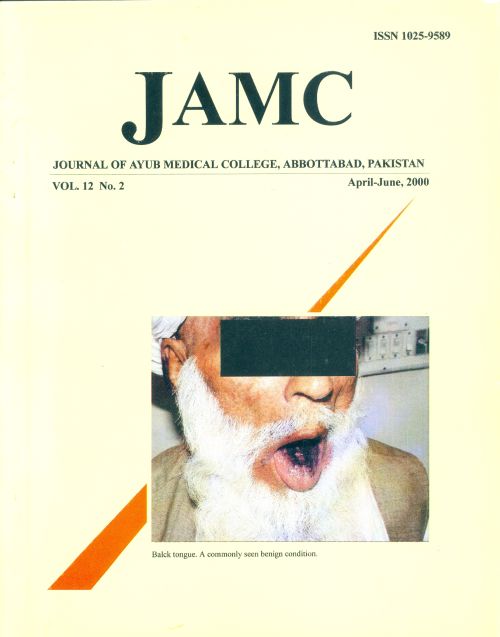INTRAPELVIC PRESSURE CHANGES IN UNILATERAL OBSTRUCTIVE NEPHROPATHY
Abstract
Background: Ureteric obstruction leads to increase in the Intrapelvic pressure and this ultimately affects the kidneyleading to structural and functional changes. It is not possible to study it in human beings. Numerous animal models
have been employed in the past. We studied these changes by using dog as the experimental model. Methods:
Intrapelvic pressure changes were studied in dogs. Right side ureters were exposed by a midline incision and were
cannulated with feeding tubes. Feeding tubes were connected to sphygmomanometer and any type of leakage was
excluded. The intrapelvic pressure was raised to 150 mmHg for 30 minutes. X-ray films were taken to reveal the
escape routes in the kidney. Results: It was observed that the intrapelvic pressure did not remain as such and a drop
of pressure by 10-12 mmHg was noted in 30 minutes. The kidney parenchyma was outlined with streaks of dye
extending from the pelvis into the renal tissue. This showed pyelovcnous, pyelolymphatic or pyelotublar pathways
which arc normally lying dormant.
References
Vaughan Jr. ED; Sorenson EJ and Gillenwater JY. The
renal haemodynamic response to chronic unilateral
complete ureteral occlusion. Urol. 1970:8 (1): 78-90
Osborn D: Lee .1 and Williams Ci. Experimental
ureteric obstruction. Brit. J. Urol. 1974:46: 15-23
Kerr Jr. WS. Effects of complete ureteral obstruction in
dogs on kidney function. Am. J. Physiol. 1956: 184
-26
Moody TE; Vaughan Jr. ED and Gillenwater JY.
Relationship between renal blood flow and ureteral
pressure during 18 hours of total unilateral ureteral
occlusion. Invest. Urol. 1975:13(3): 246-51
Brelland PM. Acute ureteric obstruction. A clinical and
radiological study. London: Butterworth's (1956)
pp.86-158.
Hinman F and Hinman Jr. F. Hydronephrosis in Lewis
Practice of Surgery Vol. VIII. Ed: W. Walter. WP. Prior
Co. Maryland (1950).
Gottschalk CW and Mylle M. Micropuncture study of
pressures in proximal tubules and peritubular
capillaries of the rat kidney and their relation to ureteral
and renal venous pressures. Am. J. Physiol. 1956: 185:
-39
Persky L; Bonte FJ and Austen Jr. G. Mechanism of
hydronephrosis: Radioautographic backflow patterns.
J. Urol. 1956: 75(2): 190-93
Salmon LL and Lanza FI... Glomerular filtration in the
rat after ureteral ligation. Am. J. Physiol. 1962:
(3): 559-64
Khan FA. Pathophysiology of acute obstructive
uropathy in Calculus renal failure, pp. 15-42. Newline
Printing Press Lahore (1981).
Bledsoe T and Murpln JJ. The relative importance of
the venous and lymphatic routes from the renal pelvis
to the circulating blood. J. Urol 1959: 81(2): 264-66
Key! MJ: Bell RD and Parry WL. Summary of the renal
lymphatic studies. J. Urol. 1973: 109: 325-29
Bell. RD. Keyl MJ; Shrader FR: Jones F.W. and Henry
LP. Renal lymphatics: 'file internal distribution
Nephron. 5: 454- 463.
Heney NM; O' Morchoe P.I and O'Morchoe CCC. The
renal lymphatic system during obstructed urine flow. J.
Urol. 1971: 106:455-62
Pvt el A. Renal colic and associated pyelorenal reflux
as a case of some disease, hit. Urol. Nepli. 1976: 8(1):
-9
How to Cite
Issue
Section
License
Journal of Ayub Medical College, Abbottabad is an OPEN ACCESS JOURNAL which means that all content is FREELY available without charge to all users whether registered with the journal or not. The work published by J Ayub Med Coll Abbottabad is licensed and distributed under the creative commons License CC BY ND Attribution-NoDerivs. Material printed in this journal is OPEN to access, and are FREE for use in academic and research work with proper citation. J Ayub Med Coll Abbottabad accepts only original material for publication with the understanding that except for abstracts, no part of the data has been published or will be submitted for publication elsewhere before appearing in J Ayub Med Coll Abbottabad. The Editorial Board of J Ayub Med Coll Abbottabad makes every effort to ensure the accuracy and authenticity of material printed in J Ayub Med Coll Abbottabad. However, conclusions and statements expressed are views of the authors and do not reflect the opinion/policy of J Ayub Med Coll Abbottabad or the Editorial Board.
USERS are allowed to read, download, copy, distribute, print, search, or link to the full texts of the articles, or use them for any other lawful purpose, without asking prior permission from the publisher or the author. This is in accordance with the BOAI definition of open access.
AUTHORS retain the rights of free downloading/unlimited e-print of full text and sharing/disseminating the article without any restriction, by any means including twitter, scholarly collaboration networks such as ResearchGate, Academia.eu, and social media sites such as Twitter, LinkedIn, Google Scholar and any other professional or academic networking site.










